Skilled cooks know that breading delicate cuts of meat provides a number of beneficial results. The crisp outer coating traps steam in the meat, keeping it moist and provides protection against overcooking. Breaded chops can be fried or baked, for a healthier alternative, but either way, the meat will remain juicy, tender and flavorful when prepared correctly.
Selection
There are several cuts of pork commonly sold as pork chops or pork steaks. Most lower-cost cuts come from the shoulder, or the less desirable end of the sirloin. Better chops are usually cut from the rib or loin, which are the tenderest large muscles on the hog. Remember to specify boneless chops, if you're buying rib chops for breading. Choose chops that show fine lines of fat, referred to as "marbling," running all through the chop. Well-marbled meat is moist and tender, and most of the fat renders out during cooking.
Preparation
Loin chops and rib chops usually have a thick edge of fat on one side. Leave a thin strip to moisten your chop, and trim the rest away. Under the fat is a layer of connective tissue which often contracts when heated, and makes the chops curl up and cook unevenly. Avoid this by using a sharp knife to make shallow cuts through the fatty side of the chop, just deep enough to penetrate the layer of connective tissue. If there is visible gristle, either trim it away or use the tip of your knife to cut it in a few places.
Tenderizing
There are many ways to make tender chops even more so. Pound the chops lightly with the smooth side of a meat mallet or a rolling pin wrapped in plastic. This parts the muscle fibers slightly, tenderizing the pork. Many meat shops sell a jacquard tenderizer, a tool with a number of sharp pins that pierce the meat and cut the fibers. Ask your butcher to run the chops through his own tenderizer, if you'd rather not take the extra time. Avoid meat tenderizing crystals, which tend to make the chops soft and mushy in texture.
Breading
The goal of breading pork chops is to make a continuous coating that will adhere to the meat, trap moisture in the chops and crisp up nicely on the outside. Dredge the chops in flour and shake off any excess. Second, dip the floured chops into a bowl filled with milk or beaten egg. Let the excess drain. Finally, coat the chops evenly by pressing them into a pan of fine breadcrumbs or panko, turning them to cover both sides. Refrigerate the chops for at least 30 minutes and preferably two hours before cooking, which helps the coating adhere.
Cooking
Thin chops are best cooked at a relatively high heat, either panfried or baked at 400 degrees F in the oven. Once the coating is crisp, the chops should be cooked through. Thicker chops require a 375 degree F oven, and can take up to 20 minutes depending on their thickness. When a meat thermometer shows 145 degrees F at the thickest part of the chop, it's done medium-rare. As of 2011, the USDA now considers this a safe temperature for pork. Those who prefer their pork well done can continue to 160 degrees F, but the chops won't be as tender.
Related Articles

Should Pork Chops Be Pink in the Middle ...

How to Cook Shoulder Lamb Chops on a ...

How to Fry Veal Cutlets
Easy Baked Pork Chops Recipe

How to Cook Thin Cut Butterfly Pork
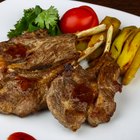
Rib Vs. Loin Grilled Lamb Chop
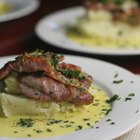
How to Cook Veal Leg Scallopini
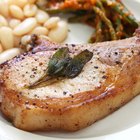
How to Grill Iowa Chops

How to Cook Venison Inside Loin

What Are Pork Cutlets?
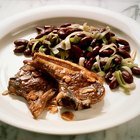
Cooking Instructions for Lamb Chops
How to Cook Boneless Lamb Butterflied ...

How to Cook Venison Chop on a Grill
How to Cook Double Thickness Rib Lamb ...
Easy Pork Chop Marinade Recipe
The Best Way to Cook Thin Cut Pork Loins
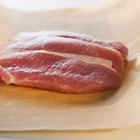
How to Cook Pork Pinwheels
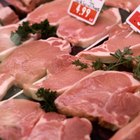
Types of Pork Chops

The Proper Way to Eat Lamb Chops

Can Beef Shoulder Roast Be Sliced and ...
References
- "On Food and Cooking: The Science and Lore of the Kitchen"; Harold S. McGee; 2004
- "Professional Cooking"; Wayne Gisslen; 2003
Writer Bio
Fred Decker is a trained chef and prolific freelance writer. In previous careers, he sold insurance and mutual funds, and was a longtime retailer. He was educated at Memorial University of Newfoundland and the Northern Alberta Institute of Technology. His articles have appeared on numerous home and garden sites including GoneOutdoors, TheNest and eHow.